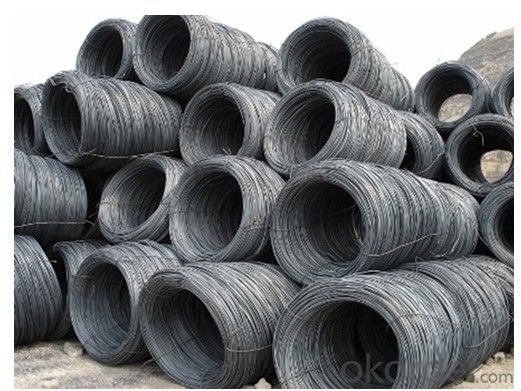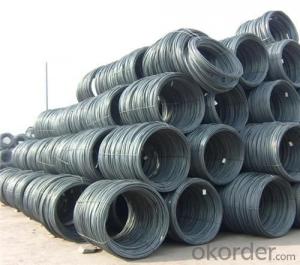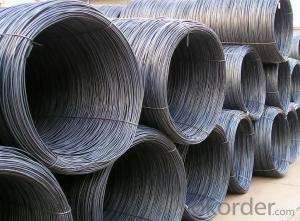Q195 low carbon wire galvanized steel wire rod
- Loading Port:
- Tianjin
- Payment Terms:
- TT OR LC
- Min Order Qty:
- 500 m.t.
- Supply Capability:
- 1000000 m.t./month
OKorder Service Pledge
OKorder Financial Service
You Might Also Like
1. Introduction:
.commodity:steel wire rod
.grade:Q195,SAE1008B-SAE1018B
.diameter:5.5mm-14mm
.type:in coil
.coil weight:around 2 mt
2. Specifications:
. Wire Gauge: 5.5mm, 6.5mm, 8mm, 9mm, 10mm, 11mm, 12mm
. Material: SAE1006, SAE1008,Q195,Q235,77B,82B
. Package: in coils
. Coil weight: 1.8-2.1 tons
. Application: Construction building, netting, package, rope and so on.
. The third party inspection: BV SGS China national construction steel quality supervision and test centre
3.Application:
Applicationwidely used in machinery parts, manufacturing industry, electronics industry, metal tools and others
4. Pictures


5.FAQ
We have organized several common questions for our clients,may help you sincerely:
①How about your company?
A world class manufacturer & supplier of castings forging in carbon steel and alloy steel,is one of the large-scale professional investment casting production bases in China,consisting of both casting foundry forging and machining factory. Annually more than 8000 tons Precision casting and forging parts are exported to markets in Europe,America and Japan. OEM casting and forging service available according to customer’s requirement.
②How to guarantee the quality of the products?
We have established the international advanced quality management system,every link from raw material to final product we have strict quality test;
- Q: What are the different wear testing methods for steel wire rod?
- There are several different wear testing methods that can be used to evaluate the performance of steel wire rods. These methods are designed to simulate real-world conditions and assess the durability and wear resistance of the wire rods. Here are some of the commonly used wear testing methods for steel wire rods: 1. Pin-on-Disk Test: In this method, a pin-shaped sample of the steel wire rod is pressed against a rotating disk under controlled conditions. The wear and frictional properties of the wire rod can be measured by analyzing the wear scar on the disk. 2. Ball-on-Disk Test: Similar to the pin-on-disk test, this method involves placing a steel ball on a rotating disk. The wear and frictional behavior of the wire rod can be evaluated by measuring the wear scar on the disk caused by the interaction between the ball and the rod. 3. Abrasion Testing: This method involves subjecting the steel wire rod to abrasive conditions to evaluate its resistance to wear. The wire rod can be tested using methods such as the Taber abrasion test or the ASTM G65 test, where the rod is rubbed against an abrasive material or surface. 4. Sliding Wear Test: This test simulates the sliding motion between two surfaces. The steel wire rod is typically placed against a counter surface, and a controlled force is applied while the surfaces slide against each other. The wear and frictional properties of the wire rod can be measured based on the wear scar on the counter surface. 5. Wear Simulation in Real Applications: In some cases, wear testing can be performed by subjecting the steel wire rod to the actual application conditions. This could involve using the wire rod in a specific machinery or equipment, and then evaluating its wear resistance based on the observed wear and performance. These different wear testing methods enable researchers and manufacturers to assess the wear resistance and durability of steel wire rods under various conditions. By understanding how the wire rod performs in different wear scenarios, improvements can be made to the material composition or manufacturing processes to enhance its wear resistance and overall performance.
- Q: What are the different types of steel wire rod surface cleaning processes?
- There are several different types of steel wire rod surface cleaning processes, including mechanical cleaning methods such as shot blasting and wire brushing, chemical cleaning methods like pickling and phosphating, and thermal cleaning methods such as flame or plasma cleaning. Each process has its own advantages and is used based on the specific requirements and desired outcome for the steel wire rod surface.
- Q: How are steel wire rods used in the production of fencing?
- The production of fencing involves the use of steel wire rods in multiple ways. Initially, these rods are the primary material for manufacturing the wires that compose the fencing structure. They are typically made from high-quality steel, which imparts strength and durability to the fencing. To initiate the production process, the steel wire rods undergo an initial cleaning and coating to prevent rusting and corrosion. Next, they are passed through a series of machines that draw them down to the desired thickness and shape. This drawing process enhances the wire's tensile strength, making it suitable for fencing purposes. Once the wire has been drawn, it undergoes further processing to create various types of fencing products. For instance, some wire rods are twisted or braided together to form chain-link fencing. These interwoven wires create a mesh-like pattern commonly used to secure residential or commercial properties. Typically, the wire rods used for chain-link fencing are galvanized or coated with PVC to increase their longevity and resistance to weathering. In addition to chain-link fencing, steel wire rods are also utilized in the production of welded wire mesh fencing. This type of fencing consists of a grid-like pattern formed by welding intersecting steel wires together. The wire rods used for welded wire mesh fencing are usually galvanized or coated with zinc to prevent rust and corrosion. In summary, steel wire rods are vital in the production of fencing as they provide the raw material necessary to create sturdy, durable, and secure fences. Their versatility allows for the manufacturing of various types of fencing, catering to different needs and requirements in both residential and commercial settings.
- Q: How are steel wire rods used in the manufacturing of surgical instruments?
- Steel wire rods are commonly used in the manufacturing of surgical instruments due to their high strength and durability. These rods are first cut into desired lengths and then shaped into various instrument components such as handles, shafts, or cutting edges. The steel wire rods serve as the base material, providing the necessary strength and integrity required for surgical instruments to withstand the rigorous demands of medical procedures.
- Q: What are the main factors influencing the choice of steel wire rod order lead time?
- The main factors influencing the choice of steel wire rod order lead time are demand and supply dynamics, production capacity, transportation logistics, and customer requirements. Firstly, demand and supply dynamics play a significant role in determining the lead time for steel wire rod orders. If there is high demand for steel wire rod products, manufacturers may have longer lead times due to increased production requirements and limited availability of raw materials. Conversely, during periods of low demand, lead times may be shorter as manufacturers can allocate resources more efficiently. Production capacity is another crucial factor. The lead time for steel wire rod orders depends on the production capacity of the manufacturer. If a manufacturer has limited production capacity, it may take longer to fulfill orders, resulting in longer lead times. On the other hand, manufacturers with larger production capacities can process orders more quickly, leading to shorter lead times. Transportation logistics also influence the choice of lead time for steel wire rod orders. If the manufacturer is located far from the customer or if there are logistical challenges, such as limited transportation options or customs clearance delays, the lead time may be longer. Efficient transportation networks and streamlined logistics processes can help reduce lead times. Additionally, customer requirements play a role in determining the lead time for steel wire rod orders. Some customers may have specific delivery deadlines or urgent requirements that need to be met. In such cases, manufacturers may prioritize these orders and provide shorter lead times to ensure customer satisfaction. Conversely, if customers have more flexible timelines, manufacturers may allocate resources to orders with shorter lead times. In conclusion, the main factors influencing the choice of steel wire rod order lead time include demand and supply dynamics, production capacity, transportation logistics, and customer requirements. Manufacturers need to consider these factors to determine an appropriate lead time that balances customer needs with operational capabilities.
- Q: How is steel wire rod used in the production of tire reinforcement materials for motorcycles?
- Steel wire rod is used in the production of tire reinforcement materials for motorcycles as it provides strength and durability. The steel wire rod is typically woven into a mesh or used as individual strands, which are then incorporated into the tire's structure to enhance its structural integrity and resistance to punctures and impacts. This reinforcement ensures that the motorcycle tires maintain their shape, grip the road effectively, and provide a safe and reliable riding experience.
- Q: How are steel wire rods used in the manufacturing of wire brushes for cleaning surfaces?
- Steel wire rods are an integral component in the manufacturing of wire brushes used for cleaning surfaces. These rods are typically made from high-quality steel, which ensures durability and longevity of the wire brushes. The manufacturing process begins with the selection of the appropriate steel wire rod, which is then cut into small sections of the desired length. These sections are straightened and then fed into a machine where they undergo a series of processes to transform them into the bristles of the wire brush. Once the wire rod sections are fed into the machine, they are first twisted together to form a bundle, creating a dense cluster of bristles. This twisting process ensures that the bristles are tightly secured together, preventing them from coming loose during use. The twisted wire bundle is then inserted into a metal ferrule, which serves as the handle of the wire brush. The ferrule is crimped or soldered onto the twisted bundle to securely attach it to the handle, ensuring the brush remains intact during heavy-duty cleaning. After the bristles are securely attached, the wire brush undergoes further manufacturing processes to give it its final shape and functionality. This may include trimming the bristles to a specific length, shaping them into a flat or angled profile, or even attaching additional features such as scraper blades or abrasive pads. Steel wire rods used in the manufacturing of wire brushes offer several advantages. The high tensile strength of steel ensures that the bristles maintain their shape and stiffness, allowing for effective and efficient cleaning. Steel wire rods are also resistant to wear and corrosion, making them ideal for use in demanding cleaning applications. In conclusion, steel wire rods play a crucial role in the manufacturing of wire brushes for cleaning surfaces. They provide the necessary strength, durability, and flexibility required for effective cleaning, ensuring that wire brushes are capable of removing dirt, grime, and debris from a variety of surfaces.
- Q: How is steel wire rod used in the manufacturing of wire rope assemblies for lifting?
- The manufacturing of wire rope assemblies for lifting requires steel wire rod as an essential component. These wire rope assemblies find extensive use in industries like construction, mining, and oil and gas sectors for lifting heavy loads. The primary purpose of steel wire rod is to serve as the raw material for producing wire ropes. These wire ropes consist of multiple strands of steel wires twisted together. They are renowned for their exceptional strength, durability, and flexibility, making them suitable for demanding lifting applications. The manufacturing process of steel wire rod involves several stages. Initially, the rod undergoes hot rolling to shape it into a long, continuous wire. This wire then undergoes cold-drawing, where its diameter is reduced and strength is increased. Subsequently, the cold-drawn wire is annealed to enhance its ductility and flexibility. Once the wire is prepared, it is twisted into strands and helically laid around a central core, forming the wire rope. The number of strands and arrangement of wires within each strand can vary according to specific application requirements. The individual wires within the strands are engineered with precision to ensure even load distribution and maximize the wire rope's strength. The properties of steel wire rod, such as high tensile strength and excellent corrosion resistance, play a vital role in the performance and reliability of wire rope assemblies. The wire rope's strength enables it to withstand heavy loads, while its corrosion resistance makes it suitable for use in challenging environments like marine or offshore applications. In conclusion, steel wire rod is crucial in the manufacturing of wire rope assemblies for lifting due to its exceptional strength, durability, and resistance to corrosion. It forms the foundation for creating wire ropes capable of safely and efficiently lifting heavy loads in various industries.
- Q: How is steel wire rod used in the manufacturing of wire forms for sliding doors?
- Steel wire rod is an essential component in the manufacturing of wire forms for sliding doors. It serves as the primary material for creating the framework and structure of the wire forms. Firstly, steel wire rod is selected for its high tensile strength and durability, making it an ideal material for withstanding the constant movement and stress that sliding doors experience. The wire rod undergoes a series of processes, including drawing and annealing, to enhance its mechanical properties and ensure it meets the required specifications. Next, the steel wire rod is formed into various shapes and sizes, depending on the specific design and requirements of the wire forms. This can be achieved through bending, cutting, and welding techniques. The wire rod is manipulated to create the necessary curves, angles, and dimensions needed to construct the sliding door wire forms. Once the wire forms are shaped, they are further processed to enhance their functionality and aesthetics. This may involve surface treatments such as galvanizing or coating to provide corrosion resistance and improve the overall appearance of the wire forms. Finally, the wire forms are assembled and integrated into the sliding door system. They are typically used to support the door panels, guide the movement of the doors along the tracks, and provide stability and smooth operation. The steel wire rod ensures that the wire forms can withstand the weight of the door panels and endure frequent opening and closing without deformation or failure. In summary, steel wire rod plays a vital role in the manufacturing of wire forms for sliding doors by providing strength, durability, and flexibility. It serves as the backbone of the wire forms, enabling them to function effectively and contribute to the overall performance of sliding doors.
- Q: How is steel wire rod transported and stored?
- Steel wire rod is typically transported and stored in large coils or bundles. These coils are loaded onto trucks, trains, or ships for transportation to various destinations. When it comes to storage, steel wire rod is often stacked in warehouses or outdoor yards, with proper measures taken to ensure stability and prevent damage. Additionally, the coils can be stored on racks or placed on flat surfaces to maintain their shape and prevent tangling.
Send your message to us
Q195 low carbon wire galvanized steel wire rod
- Loading Port:
- Tianjin
- Payment Terms:
- TT OR LC
- Min Order Qty:
- 500 m.t.
- Supply Capability:
- 1000000 m.t./month
OKorder Service Pledge
OKorder Financial Service
Similar products
Hot products
Hot Searches
Related keywords



























